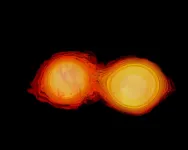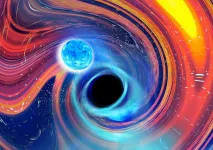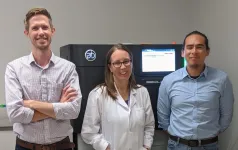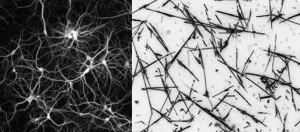(Press-News.org) Sophia Antipolis - 29 June 2021: Heart attacks during the COVID-19 pandemic were more likely to result in heart failure compared with heart attacks one year earlier, according to research presented today at Heart Failure 2021, an online scientific congress of the European Society of Cardiology (ESC).1
"Heart attack patients waited an average of 14 hours to get help during the pandemic, with some delaying for nearly two days. That compares to a delay of six hours in the previous year," said study author Dr. Ali Aldujeli of the Hospital of Lithuanian University of Health Sciences, Kaunas, Lithuania. "This gap may have been one contributor to the higher incidence of subsequent heart failure."
Urgent treatment for heart attacks is essential to restore the flow of oxygen-rich blood to the heart muscle. A longer duration of oxygen deprivation is associated with a greater area of damaged muscle and reduced pump function (called ejection fraction), which is a type of heart failure.
This study compared treatment delays, post-treatment ejection fraction, and decompensated heart failure hospitalisation rate in heart attack patients before versus during the COVID-19 pandemic.
The retrospective, multicentre study covered six out of ten administrative regions in Lithuania. The study included consecutive patients with acute myocardial infarction who received a negative test result for COVID-19 infection between 11 March and 20 April 2020 and underwent invasive treatment. The data were compared to patients admitted with the same diagnosis during the same period in 2019. Patients were followed up for six months following hospital discharge.
A total of 269 heart attack patients were evaluated in the study. There was a 34.0% decline in heart attack admissions during the early phase of the pandemic compared to the same period in 2019. Patients waited significantly longer before presenting to hospital during the pandemic compared to 2019 (a median of 858 versus 386 minutes, respectively).
Admission rates and delays were less pronounced for heart attacks with complete blockage of the heart arteries (ST-elevation myocardial infarction; STEMI) compared to non-STEMI. Admission rates fell by 22.1% for STEMI and 47.4% for non-STEMI. Patient delays more than doubled for STEMI patients during the pandemic and increased by more than fourfold for non-STEMI patients.
Dr. Aldujeli said: "Declines in admissions and delays in seeking treatment may be partly attributed to the extensive media coverage which amplified patients' fear of contracting COVID-19 and precluded them from seeking timely medical care. A possible explanation for the differences according to type of heart attack could be because STEMI patients tend to have more acute and intense symptoms compared to those with non-STEMI."
Post-treatment pump function was significantly lower during the pandemic compared to 2019. At six months, 22% of patients who had a heart attack during the pandemic were admitted to the hospital with decompensated heart failure compared to 2.5% in 2019.
When the authors examined the results by type of heart attack, they found that at six months, nearly one-third of patients (30%) who had non-STEMI during the pandemic were admitted to the hospital for decompensated heart failure compared to 1.3% in 2019. For STEMI, the corresponding proportions of admissions were 16.4% during the pandemic versus 3.5% in 2019.
Dr. Aldujeli said the outcomes according to type of heart attack may have been influenced by new pandemic-specific protocols implemented to prevent spread of the virus. Patients diagnosed with STEMI according to an electrocardiogram (ECG) were prioritised for urgent treatment (i.e. without waiting for a COVID-19 test result) and staff used personal protective equipment (PPE) during the procedure. Patients with non-STEMI were deemed less urgent and were isolated for around 24 hours while waiting for COVID-19 test results, which dictated whether staff needed PPE during the procedure or not.
Dr. Aldujeli said: "Our findings suggest that all heart attacks during a pandemic should be treated urgently with staff using PPE. More balanced media coverage is also needed so that patients do not wait to seek help in medical emergencies."
INFORMATION:
Authors: ESC Press Office
Tel: +33 (0)4 89 87 20 85
Mobile: +33 (0)7 8531 2036
Email: press@escardio.org
Follow us on Twitter @ESCardioNews
Notes to editor
Funding: The study was funded in part by the Baylor Health Care System Foundation, USA.
Disclosures: None.
References and notes
1Abstract title: Association between delayed revascularization during the covid-19 pandemic and rates of post myocardial infarction heart failure hospitalizations.
About Heart Failure 2021 & World Congress on Acute Heart Failure
Heart Failure is the annual congress of the Heart Failure Association (HFA) of the European Society of Cardiology (ESC).
#HeartFailure2021
About the Heart Failure Association
The Heart Failure Association (HFA) is a branch of the European Society of Cardiology (ESC). Its aim is to improve quality of life and longevity, through better prevention, diagnosis and treatment of heart failure, including the establishment of networks for its management, education and research.
About the European Society of Cardiology
The European Society of Cardiology brings together health care professionals from more than 150 countries, working to advance cardiovascular medicine and help people lead longer, healthier lives.
Information for journalists about registration for Heart Failure 2021
Heart Failure 2021 takes place held 29 June to 1 July online. Explore the scientific programme.
Free registration applies only to accredited press.
Credentials: A valid press card or appropriate letter of assignment with proof of three recent published articles (cardiology or health-related or referring to a previous ESC event). Read the ESC media and embargo policy.
The ESC Press Office will verify the documents and confirm by email that your press accreditation is valid.
The ESC Press Office decision is final regarding all press registration requests.
Scientists have for the first time detected black holes eating neutron stars, "like Pac Man", in a discovery documenting the collision of the two most extreme and enigmatic objects in the Universe.
The Laser Interferometer Gravitational-Wave Observatory (LIGO) in the US and the Virgo gravitational-wave observatory in Italy have captured the gravitational waves from the death spiral and merger of a neutron star with a black hole, not once but twice. The findings are published today.
The researchers say their observations will help unlock some of the most complex mysteries of the Universe, including the building blocks of matter and the workings of space and time.
More than 1,000 scientists were involved with the ...
As smoky air becomes more common during Washington's wildfire season, many wildlife enthusiasts wonder: What happens to the birds?
Few studies have looked at wildfire smoke impacts on animals, let alone birds. And as Washington and the larger West Coast continue to experience more massive wildfires and smoke-filled air, understanding how birds are affected by smoke -- and how air pollution may influence our ability to detect birds -- are important factors for bird conservation.
Researchers from the University of Washington now provide a first look at the probability of observing common birds as air pollution worsens during wildfire seasons. They found that smoke affected the ability to detect more than a third of the bird species studied ...
For the first time, researchers have confirmed the detection of a collision between a black hole and a neutron star. In fact, the scientists detected not one but two such events occurring just 10 days apart in January 2020. The extreme events made splashes in space that sent gravitational waves rippling across at least 900 million light-years to reach Earth. In each case, the neutron star was likely swallowed whole by its black hole partner.
Gravitational waves are disturbances in the curvature of space-time created by massive objects in motion. During the five years since the waves were first measured, a finding that led to the END ...
A long time ago, in two galaxies about 900 million light-years away, two black holes each gobbled up their neutron star companions, triggering gravitational waves that finally hit Earth in January 2020.
Discovered by an international team of astrophysicists including Northwestern University researchers, two events -- detected just 10 days apart -- mark the first-ever detection of a black hole merging with a neutron star. The findings will enable researchers to draw the first conclusions about the origins of these rare binary systems and how often they merge.
"Gravitational ...
Gravitational wave detectors have observed a new type of cataclysmic event in the cosmos: the merger of a neutron star with a black hole.
The phenomenon was detected twice in January 2020.
Several hypotheses could explain the existence of such mixed pairs. Further observations will be needed in order to settle the question.
Another missing piece has just been added to our knowledge of cosmic phenomena. The LIGO, Virgo and KAGRA collaborations have announced the first detection of gravitational waves (1) resulting from the 'mixed' merger between a black hole and a neutron star (2). The discovery, published on June 29, 2021 in Astrophysical Journal Letters, involves CNRS researchers working within ...
LOUISVILLE, Ky. - Historically, most large-scale immunogenomic studies - those exploring the association between genes and disease - were conducted with a bias toward individuals of European ancestry. Corey T. Watson, Ph.D., assistant professor in the University of Louisville Department of Biochemistry and Molecular Genetics, is leading a call to actively diversify the genetic resources he and fellow immunogenomics researchers use in their work to advance genomic medicine more equitably.
Watson, along with UofL post-doctoral fellow Oscar Rodriguez, Ph.D., and visiting fellow Yana Safonova, Ph.D., are part of an international group of researchers ...
PHILADELPHIA -- (June 29, 2021) -- New biomarkers that predict HIV remission after antiretroviral therapy (ART) interruption are critical for the development of new therapeutic strategies that can achieve infection control without ART, a condition defined as functional cure. These biomarkers can also provide critical clues into the biological mechanisms that control HIV replication after stopping therapy, and can help design novel strategies to cure HIV. Scientists at The Wistar Institute have identified metabolic and glycomic signatures in the blood of a rare population of HIV-infected individuals who can naturally sustain viral suppression after ART cessation, known as post-treatment controllers. These findings were published in Nature ...
Scientists at the University of Sydney and Japan's National Institute for Material Science (NIMS) have discovered that an artificial network of nanowires can be tuned to respond in a brain-like way when electrically stimulated.
The international team, led by Joel Hochstetter with Professor Zdenka Kuncic and Professor Tomonobu Nakayama, found that by keeping the network of nanowires in a brain-like state "at the edge of chaos", it performed tasks at an optimal level.
This, they say, suggests the underlying nature of neural intelligence is physical, and their discovery opens an exciting avenue for the development of artificial intelligence.
The study is published today in Nature Communications.
"We used wires 10 micrometres long and no thicker than 500 nanometres ...
Researchers from Queen Mary University of London have identified a protein that could be used to aid in the diagnosis of pancreatic cancer.
Findings from the new study suggest that a protein called pentraxin 3 (PTX3) may be a specific diagnostic biomarker - or biological measure - for pancreatic cancer, with the ability to differentiate pancreatic cancer from other non-cancerous conditions of the pancreas.
The research was published today in npj Precision Oncology, and primarily funded by the Pancreatic Cancer Research Fund, Barts Charity and Cancer Research UK.
PTX3 levels elevated in patients with pancreatic ...
This press release is in support of a presentation by Dr Maria Cerrillo Martinez presented online at the 37th Annual Meeting of ESHRE.
29 June 2021: Fertility patients who have a poor response to ovarian stimulation represent a stubborn challenge in IVF. Few eggs are collected, success rates are low, and several treatments are usually needed to achieve pregnancy (if at all). Clinical guidelines indicate that increasing the drug dose for stimulation or applying any of several adjunct therapies are of little benefit. Now, however, a study assessing two cycles of ovarian stimulation and two egg collections in the same menstrual cycle may yet provide ...





